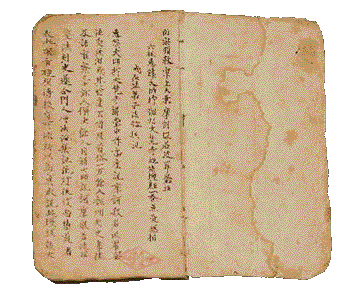Hui Neng - The Writting
About the The Platform Sutra
(T'an Ching)*
The Platform Sutra, Dunhuang manuscript, (c. 830-860), page 1. (Image source: https://terebess.hu/zen/huineng-eng.html |
The T'an Ching, or Platform Sutra, has been a volume of immense popularity among the Ch'an Buddhists of East Asia for many centuries. Purported to be the teaching of the Sixth Patriarch of the Southern School of Ch'an, it has achieved the highest status possible for a Buddhist text by being awarded the title of "ching" (sutra), which places it on equal ground with the words attributed directly to
the Buddha. In the latter half of the T'ang dynasty, when the various schools of Chinese Buddhism began to be amalgamated and absorbed into one another, the importance of Ch'an increased; and as it became the dominant school in China, the T'an ching rose to the prominent position it has continued to hold right up to the present day. In the West as well, partly because of the writings of D. T. Suzuki and the international impact of Japanese culture, Ch'an and
Zen have become extremely popular; and it is not surprising, therefore, to find the T'an Ching ranking as one of the best known of all Buddhist texts. Because of its significance for Asia as well as for the West, the book has received much attention from both researchers and translators. [...] For the past 500 years the T'an Ching, known and studied in China, has been a version of the text included in the Ming dynasty edition of
the Buddhist canon (1440). This version represents the work of a Yuan dynasty monk named Tsung-pao, who produced a new edition of the text in 1291 on the basis of three different manuscripts. In 1900 another version of the text was discovered in the famous Buddhist cave library at Tun-huang. The exact date of this manuscript is unknown but it is considered by scholars to be a work of the last years of the T'ang dynasty. Thus, it is the earliest extant
copy of the T'an ching, dating back perhaps to within a century-and-a-half of the death of the Sixth Patriarch (713). [...] The Tun-huang manuscript, however, is by no means a perfect copy: it contains a number of obvious corruptions of various sorts. Consequently, the text can not be read without considerable editing. Fortunately, two other early copies related to the Tun-huang manuscript were discovered in Japan in the 1930s. One is known as
the Koshoji text, a Northern Sung printed copy probably derived ultimately from an edition, no longer extant, done in 967. The other, known as the Daijoji text, is a handwritten manuscript traditionally attributed to the Japanese Soto Zen patriarch Dogen (1200-1253). The exact historical relationship between these two is not clear; in general, however, they are quite similar and appear to represent a textual tradition not too different from the Tun-huang text. Hence,
they are of great value in determining the reading of the Tun-huang manuscript.
--
*Abstract from T'an Ching (Platform Scripture) By Carl Bielefeldt and Lewis Lancaster Philosophy East and West, Vol. 25, no. 2 (1975), P. 197- 212.
Basics - Quotes - Search - Resources
Copyright 2009-2023, Way of Perfect Emptiness.![]()
